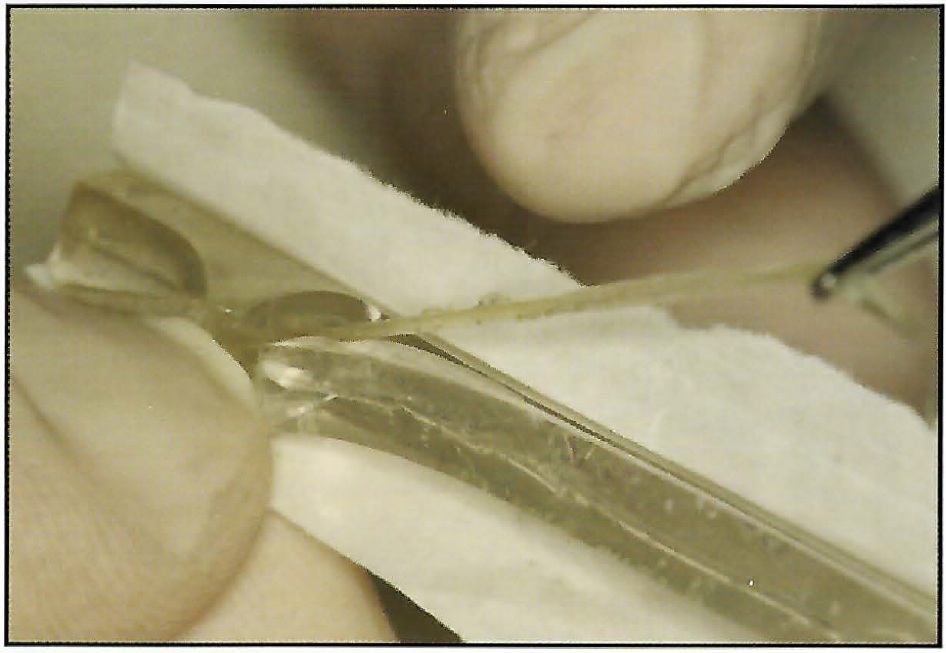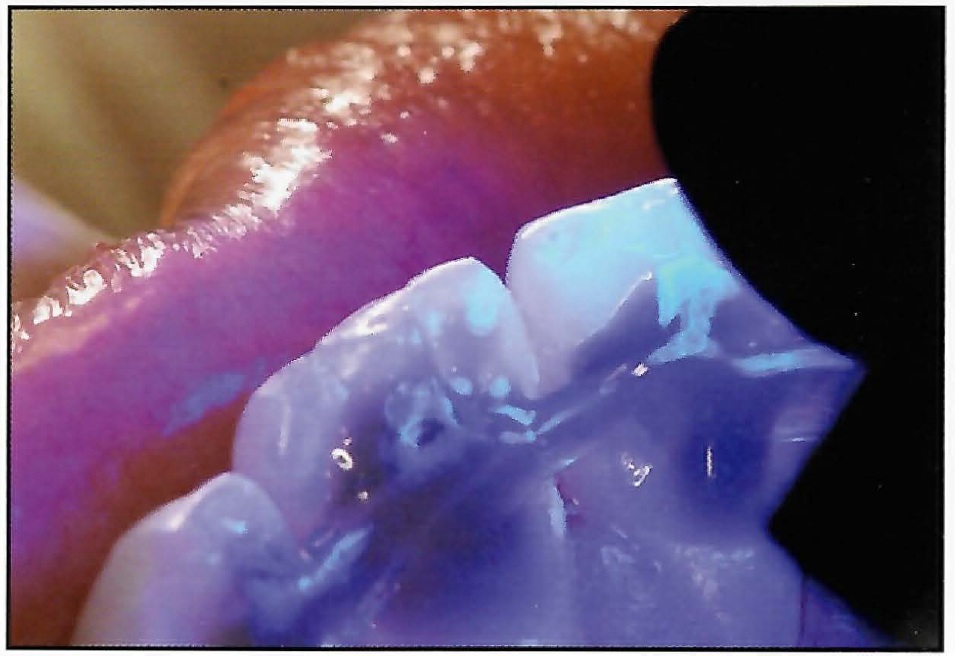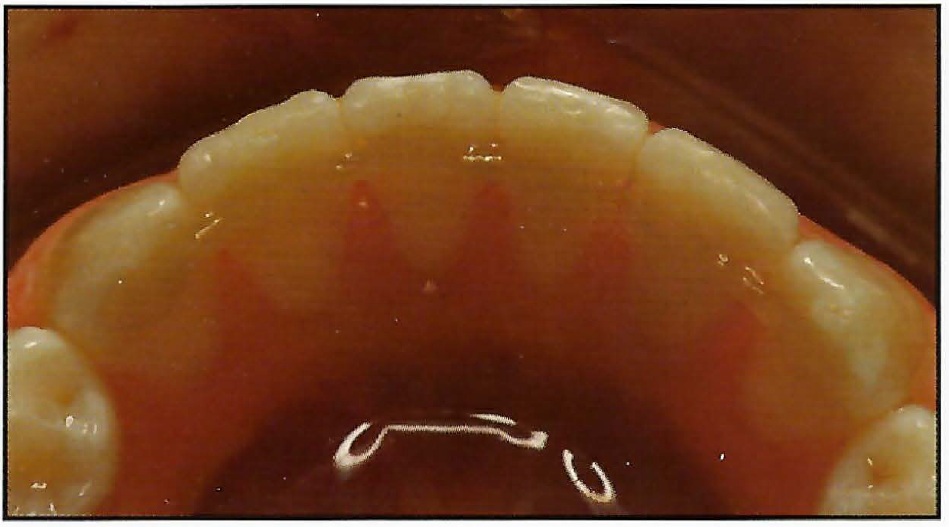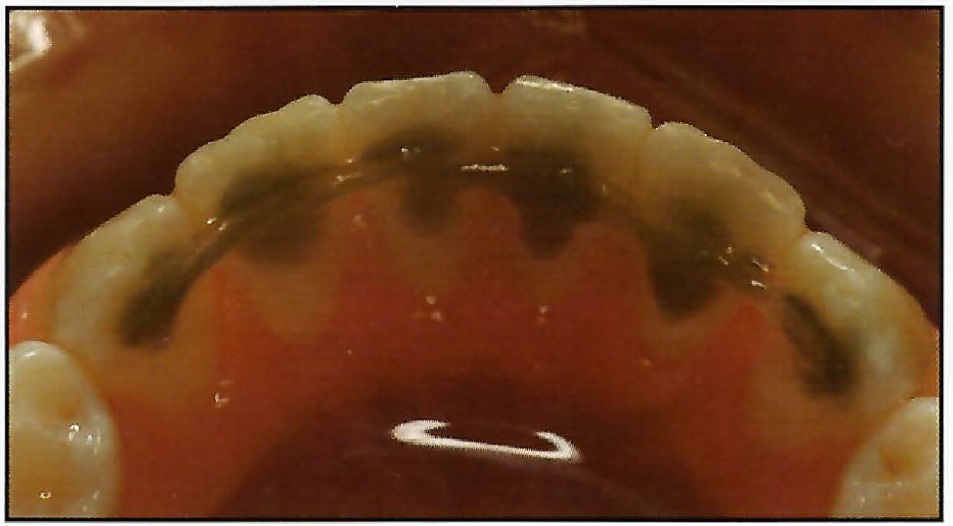Bonding Fiber-Reinforced Lingual Retainers with Color-Reactivating Flowable Composite
Fiber-reinforced composites (FRCs) have been developed as esthetic and metal-free alternatives for various dental materials, including prosthodontic bridges and crowns, periodontal splints, and orthodontic retainers.1-4 In orthodontics, Burstone and Kuhlberg have advocated the use of FRCs for both passive and active applications.5
The first attempts to make FRC retainers involved using long, continuous fibers that were saturated with resin and bonded to the teeth. These first-generation retainers were too rigid to allow tooth movement, however, and the fibers and bonding adhesives were technically unsatisfactory.
Recent developments have solved these problems. EverStick Ortho* is a glass fiber bundle that is pre-impregnated with a polymethylmethacrylate polymer. The surface of the fiber framework is partially dissolved with resin, providing both micromechanical and chemical adhesion. Studies have demonstrated adequate bonding of the fiber to the composite resin.6
Both the retainer material and the composite appear to be critical in successful bonding of lingual retainers.7 Flexible wires have the highest failure rate among common materials, with many bond failures due to fracture of the wires themselves.7,8 A reinforced polyethylene fiber material is just as difficult to cover completely with resin. Using light-cured, color-reactivating composite (Tetric Flow Chroma**) rather than a tooth-colored composite gives the clinician a better opportunity to monitor cracks, failures, and inadequate interface between the adhesive and the tooth surface. Another advantage of this flowable resin is that there is no need for finishing or polishing, which saves chairtime.9-12
Similar articles from the archive:
Placement Procedure
- After debonding the fixed appliance, pumice the lingual tooth surfaces to be bonded, using a fluoride-free paste.
- Measure the correct length for the everStick Ortho with dental floss.
- Open the foil package and slide out the silicone sleeve containing the fiber bundle (Fig. 1). Cut the fiber to the measured length, keeping it away from light exposure.
- Etch the enamel surfaces with 37% phosphoric acid for 60 seconds, then rinse and air-dry.
- Apply a light-cured adhesive to the lingual surfaces, followed by a thin layer of Tetric FlowChroma.
- Holding the fiber bundle with a tweezer, dip one end into the Tetric Flow Chroma.
- Adapt this end to the appropriate tooth surface, and light-cure it for five seconds, shielding the rest of the bundle from the curing light.
- Continue adapting and curing the fiber retainer tooth by tooth.
- After this initial tacking, cover the interproximal portions of the fiber with a thin layer of TetricFlow Chroma, and light-cure it for 40 seconds (Fig. 2). The light-activated composite will have a dark green color, making it easy to identify.

Fig. 1 EverStick Ortho* glass fiber bundle in silicone sleeve.

Fig. 2 Final light-curing of flowable composite in interproximal areas.

Fig. 3 Fiber completely covered by composite in finished retainer.

Fig. 4 Composite exposed to ultraviolet light for subsequent retainer check.
Conclusion
Compared to conventional retainer materials, everStick Ortho is easy to place, with no need to adapt it to the study casts beforehand. It is suitable for use in patients with metal allergies.
A light-cured, color-reactivating composite facilitates visual monitoring for removal of excess adhesive, thus avoiding undue thickness, which can cause plaque retention and gingival inflammation. Since only the essential area of enamel is bonded, this technique also limits the potential for damaging the lingual enamel when the retainer and adhesive are removed.
FOOTNOTES
- *Registered trademark of Stick Tech Ltd., P.O. Box 114, 20521 Turku, Finland. Distributed by Benco Dental Co., Wilkes-Barre, PA; G&H Wire Company, Greenwood, IN; and Preat Corporation, Santa Ynez, CA.
- **Ivoclar Vivadent, Inc., 175 Pineview Drive, Amherst, NY 14228. Tetric is a registered trademark.
REFERENCES
- 1. Hugo, B.: Chairside fiber-reinforced resin composite fixed partial dentures, Inf. Orthod. Kieferorthop. 35:55-63, 2003.
- 2. Karaman, A.I.; Kir, N.; and Belli, S.: Four applications of reinforced polyethylene fiber material in orthodontic practice, Am. J. Orthod. 121:650-654, 2002.
- 3. Rantala, L.I.; Lastumäki, T.M.; Peltomäki, T.; and Vallittu, P.K.: Fatigue resistance of removable orthodontic appliance reinforced with glass fibre weave, J. Oral Rehabil. 30:501-506, 2003.
- 4. Vallittu, P.K. and Sevelius, C.: Resin-bonded, glass fiber-reinforced composite fixed partial dentures: A clinical study, J. Prosth. Dent. 84:413-418, 2000.
- 5. Burstone, C.J. and Kuhlberg, A.J.: Fiber-reinforced composites in orthodontics, J. Clin. Orthod. 34:271-279, 2000.
- 6. Lastumäki, T.M.; Kallio, T.T.; and Vallittu, P.K.: The bond strength of light-curing composite resin to finally polymerized and aged glass fiber-reinforced composite substrate, Biomater. 23:4533-4539, 2002.
- 7. Artun, J.; Spadafora, A.T.; and Shapiro, P.A.: A 3-year follow-up study of various types of orthodontic canine-to-canine retainers, Eur. J. Orthod. 19:501-509, 1997.
- 8. Dahl, E.H. and Zachrisson, B.U.: Long-term experience with direct-bonded lingual retainers, J. Clin. Orthod. 25:619-630, 1991.
- 9. Attar, N.; Tam, L.E.; and McComb, D.: Flow, strength, stiffness and radiopacity of flowable resin composites, J. Can. Dent. Assoc. 69:516-521, 2003.
- 10. Elaut, J.; Asscherickx, K.; Vande Vannet, B.; and Wehrbein, H.: Flowable composites for bonding lingual retainers, J. Clin. Orthod. 36:597-598, 2002.
- 11. Geserick, M. and Wichelhaus, A.: A color-reactivated flowable composite for bonding lingual retainers, J. Clin. Orthod. 38:165-166, 2004.
- 12. Moon, P.C.; Tabassian, M.S.; and Culbreath, T.E.: Flow characteristics and film thickness of flowable resin composites, Oper. Dent. 27:248-253, 2002.




